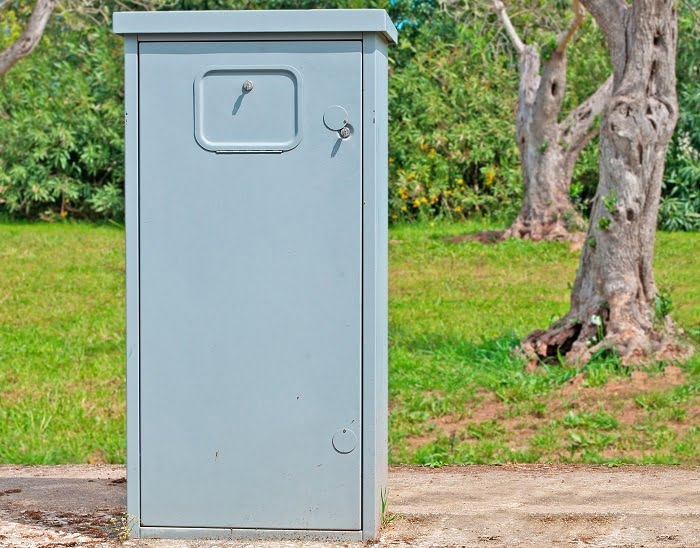What Is the Best Way to Cool An Outdoor Electrical Enclosure?

An electrical enclosure located outdoors faces a number of unique challenges. Apart from exposure to all kinds of weather, the ambient temperature in summer is high and the effect of solar radiation must be considered. In these conditions, it is likely the internal enclosure temperature will be elevated and may exceed safe limits unless the enclosure is equipped with some form of enclosure cooling.
Specific Factors Affecting Temperature of Outdoor Electrical Enclosures
It’s a well-known fact that excessive temperature affects the life and reliability of electrical equipment. Although certain types of electrical equipment are robust, others cannot tolerate the high temperatures often found in outdoor enclosures. As a rule of thumb, the maximum enclosure temperature should be at least 10 °F lower than the manufacturer’s recommended maximum operating temperature. Factors that are likely to lead to high outdoor electrical enclosure temperatures include:
- Enclosure heat load: This is the heat generated by the equipment inside the enclosure and, depending on the type of equipment, it can be significant.
- Solar radiation: The heating effect of the sun on the enclosure significantly increases its internal temperature, even when insulation is installed.
- Ambient temperature: In summer, high ambient temperatures limit the effectiveness of natural and forced cooling solutions, and they directly impact on the required cooling capacity.
- Enclosure size: A large enclosure dissipates heat better than a small one. However, a large surface area also increases the heating effect of solar radiation.
Outdoor Enclosure Cooling Solutions
An outdoor enclosure cooling solution must be able to keep the enclosure temperature below the maximum equipment temperature and counter the combined effects of ambient temperature, solar radiation and heat load. In many instances, this means that natural ventilation or fan cooling will be insufficient, except for particularly robust equipment. This is because fans can only remove heat; they cannot cool to below the ambient temperature. The limitation of cooling fans can be demonstrated by using an enclosure temperature management calculator to calculate the required cooling capacity and, in most instances, shows that the most effective outdoor electrical enclosure cooling solution is an enclosure air conditioner.
Mitigating Solar Radiation
Several techniques are available to reduce the effects of solar radiation and to reduce the required cooling capacity for outdoor electrical enclosures. The simplest technique is to place the enclosure in a north-south orientation. This reduces the total surface area exposed to the sun. Light, reflective colors or a highly polished stainless steel finish also reflect the sun’s rays and reduce the effects of solar radiation. Another solution that is very effective are sunshades placed to keep the sun off the walls of the enclosure during the heat of the day.
Protection Against the Elements
Outdoor enclosures are subject to wind, rain, snow, ice, dirt and dust, and the equipment must be protected against these elements. It’s essential that water does not enter the enclosure, even during abnormal weather conditions. Additionally, an enclosure air conditioner operates on a closed loop cooling cycle, which precludes the use of a ventilated enclosure, so a sealed electrical enclosure is necessary. These constraints can be met through the use of NEMA Type 4 enclosures that are resistant to water ingress, even from windblown spray. Both the electrical enclosure and the enclosure air conditioner should have this rating as a minimum requirement.
A NEMA Type 4 enclosure is also dustproof and provides complete protection against windblown dust and dirt. However, if corrosive vapors are present, a NEMA Type 4X enclosure is better because it protects against corrosion, and in particular, against coastal salt spray and mist. In corrosive locations, it’s advisable to specify a corrosion protection package that provides additional protection to the condenser coil.
Enclosure Monitoring
Outdoor electrical enclosures are often in remote locations and situated well away from maintenance personnel. Although some level of preventive maintenance is needed, these enclosures are unattended for long periods of time and it’s advisable to employ some form of remote monitoring. This may be as simple as a dry contact that closes if the enclosure temperature gets too high and triggers a remote alarm. A more sophisticated solution such as a remote control and monitoring system using the Ethernet or a PLC communication protocol offers increased functionality.
The reliability of electrical equipment is directly related to operating temperature, and in many instances, outdoor electrical enclosures should be equipped with enclosure air conditioners to ensure their temperature is kept below the maximum allowed equipment temperature. Thermal Edge enclosure air conditioning solutions are robust, reliable and ideally suited for use in hot, dirty outdoor conditions. Models are available for use with 48 VDC power sources for telecom applications. If you are experiencing overheating in outdoor enclosures, contact our Sales Team and let us show you how to overcome outdoor electrical enclosure overheating.


